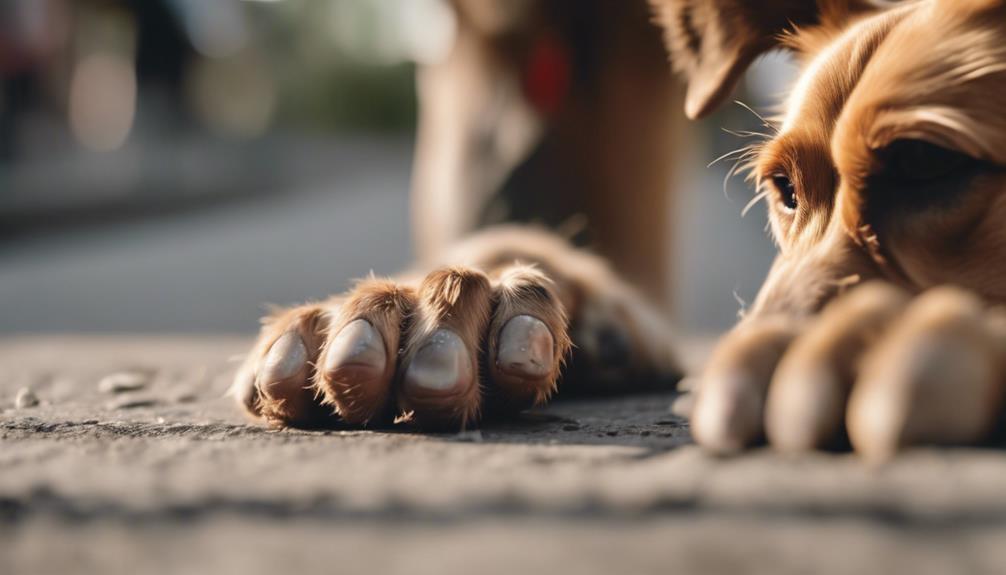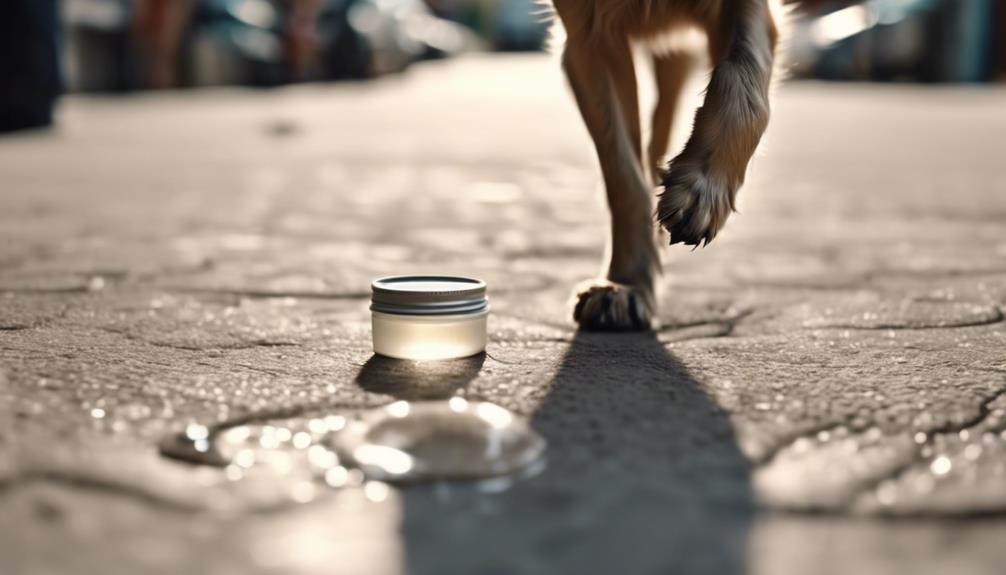In the realm of canine health, the vulnerability of a dog's paw pads to burns from hot pavement is a pertinent concern for pet owners. Recognizing the subtle signs of paw pad injuries and adopting immediate cooling measures are crucial steps in managing such incidents.
However, beyond reactive interventions lies a proactive approach centered on preventing these painful occurrences altogether. By exploring preemptive measures and practical strategies, pet owners can navigate the delicate balance between outdoor activity and paw protection, ensuring their dog's paws remain unscathed and healthy.
Key Takeaways
- Use pet-safe products to prevent chemical burns.
- Choose cooler times and grassy surfaces for walks.
- Consider protective socks or booties for paw pad protection.
- Test pavement temperature before walking to avoid burns.
Identifying Burned Dog Paw Symptoms
Recognizing burned dog paw symptoms is crucial for pet owners to promptly address potential injuries and ensure the well-being of their furry companions. Signs of burned paw pads include limping, licking or chewing at the paws, reluctance to walk, redness or swelling on the paw surface, blisters, or even missing pieces of paw pad tissue.
Additionally, dogs may exhibit signs of pain such as whimpering or guarding their paws. It is essential to carefully inspect the paws for any of these symptoms, especially after walks on hot pavement or exposure to chemicals.
Immediate Cooling and Soothing Steps
To provide immediate relief for burned dog paw pads, prompt cooling and soothing measures are essential to alleviate discomfort and prevent further injury. One effective method is to immediately soak the affected paws in cool water to help dissipate the heat and reduce inflammation. Additionally, gently patting the paws dry with a soft towel can prevent any irritation. A soothing paw balm or aloe vera gel can be applied to help moisturize and promote healing. Remember to avoid using any products with potentially harmful ingredients that can be ingested by the dog when they lick their paws. Here is a table highlighting some cooling and soothing steps for burned dog paw pads:
| Cooling and Soothing Steps | |
|---|---|
| Soak paws in cool water | Use gentle patting to dry |
| Apply soothing paw balm | Avoid harmful ingredients |
| Consider aloe vera gel | Monitor for signs of improvement |
Proper Care for Minor Paw Burns

Following immediate cooling and soothing measures for burned dog paw pads, proper care for minor paw burns involves gentle cleaning and monitoring for signs of healing to ensure optimal recovery.
To clean the burned area, use a mild antiseptic solution or saline solution to prevent infection. Gently pat the paw dry with a clean towel and avoid rubbing the sensitive skin. Keep the paw clean and dry to promote healing.
Monitor the burned pad for any signs of redness, swelling, or discharge, which could indicate an infection. Minor burns typically heal within a week with proper care, but if you notice any concerning changes or lack of improvement, seeking veterinary advice is recommended to prevent complications.
Seeking Veterinary Attention for Severe Burns
Seeking veterinary attention for severe burns in dogs is imperative to ensure proper evaluation and treatment of the paw pad injuries. When dealing with severe burns on a dog's paw pads, it is essential to take the following actions:
- Professional Examination: A veterinarian will assess the extent of the burns, determine if there are any underlying complications, and recommend appropriate treatment.
- Pain Management: Veterinarians can provide pain relief medications to alleviate discomfort and ensure the dog's well-being during the healing process.
- Preventative Measures: Veterinary guidance can help prevent infections, promote proper healing, and offer advice on future paw pad protection to avoid similar incidents.
Prompt veterinary care is crucial for ensuring the best possible outcome for the dog's recovery.
Preventing Paw Pad Burns in Dogs

When addressing the well-being of dogs' paw pads, prioritizing preventative measures is essential to safeguard against potential burns and ensure their comfort and mobility.
To prevent paw pad burns in dogs, it is crucial to use pet-safe products to avoid chemical injuries and opt for cooler times of the day for outdoor walks. Additionally, choosing grassy surfaces over hot pavement can help protect their sensitive paw pads.
Consider using socks or booties for extra protection, especially in extreme weather conditions. Testing pavement temperature with your hand before walking your dog can also prevent burns.
Importance of Paw Pad Protection
Protecting a dog's paw pads is essential for maintaining their mobility and comfort across various terrains. Without proper protection, paw pads are susceptible to burns and injuries that can significantly impact a dog's quality of life. Here are three reasons highlighting the importance of paw pad protection:
- Mobility: Intact paw pads ensure that dogs can walk, run, and play without discomfort or restrictions.
- Comfort: Healthy paw pads contribute to a dog's overall comfort, allowing them to enjoy daily activities without pain.
- Safety: Protected paw pads reduce the risk of burns, cuts, and infections, promoting a safer and healthier lifestyle for your furry friend.
Conclusion
In conclusion, recognizing the symptoms of burned paw pads in dogs is the first step. Taking immediate cooling measures and providing proper care for minor burns are crucial. Seeking veterinary help for severe injuries is essential. Implementing preventive measures is also important in maintaining the health and well-being of a dog's paws.
By prioritizing paw pad protection and proactive care, dog owners can ensure their furry companions are safeguarded from the discomfort and potential hazards of hot pavement.




